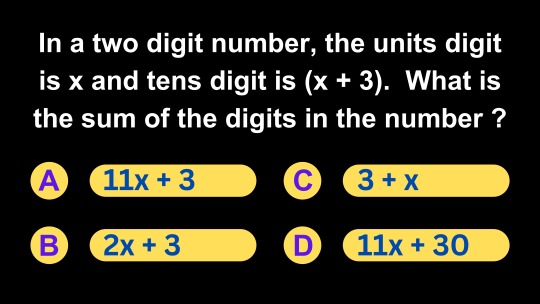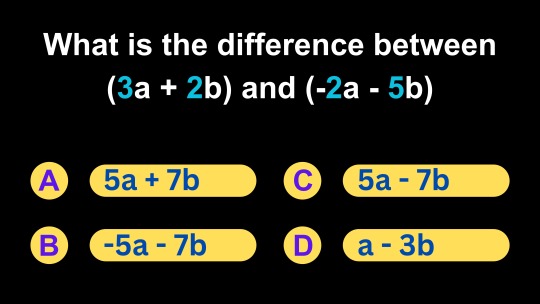#SATMathematics
Text

The SAT Math section assesses your mathematical skills, including your ability to work with numbers and expressions. Understanding how to analyze and calculate properties of two-digit numbers is essential for solving math problems on the SAT and in real-life scenarios. In this video, we will explore a SAT Math question that involves finding the sum of the digits in a two-digit number: "In a two-digit number, the units digit is x, and the tens digit is (x + 3). What is the sum of the digits in the number?" The correct answer is Option D) 11x + 30. By the end of this exploration, you will have a clear understanding of how to find the sum of digits in such numbers, improving your performance on the SAT Math section.
Question: Finding the Sum of Digits in a Two-Digit Number
Question: In a two-digit number, the units digit is x, and the tens digit is (x + 3). What is the sum of the digits in the number?
Options:
A) 11x + 3
B) 2x + 3
C) 3 + x
D) 11x + 30
Explanation and Key Concepts: When dealing with two-digit numbers, you can represent them as 10 times the tens digit plus the units digit. In this problem, the tens digit is (x + 3), and the units digit is 'x.' The sum of the digits is found by adding the tens and units digits, which leads to the expression 11x + 30.
Analyzing and calculating properties of two-digit numbers is an essential skill for the SAT Math section and beyond. This skill allows you to manipulate numbers and solve various mathematical problems efficiently. By mastering this skill, you'll not only excel on the SAT but also enhance your overall mathematical proficiency, which can be applied to various real-life scenarios.
#SATMathTips#AlgebraSimplification#MathExpression#SATMathPrep#MathematicsTutorial#SATMathProblems#TestPreparation#SATExamTips#MathSimplification#SATMathematics#SATTest#MathHelp#ProblemSolving#SATMathSkills#AlgebraicExpression#MathematicalEquivalence#SATStudy#MathExplained#SATPreparation#MathConcepts
0 notes
Text

The SAT Math section assesses your mathematical skills, including your ability to perform operations with algebraic expressions and identify their differences. Understanding how to find the difference between two expressions is essential not only for the SAT but also for various mathematical and real-life scenarios. In this video, we will explore a SAT Math question that involves finding the difference between two algebraic expressions: "What is the difference between (3a + 2b) and (-2a - 5b)?" The correct answer is Option A) 5a + 7b. By the end of this exploration, you will have a clear understanding of how to find the difference of algebraic expressions, enhancing your performance on the SAT Math section.
Question: Finding the Difference of Algebraic Expressions
Question: What is the difference between (3a + 2b) and (-2a - 5b)?
Options:
A) 5a + 7b
B) -5a - 7b
C) 5a - 7b
D) a - 3b
Correct Answer: Option A) 5a + 7b
Explanation and Key Concepts: Finding the difference between two algebraic expressions involves subtracting one expression from the other and then combining like terms. Remember that subtracting a negative expression is equivalent to adding the positive expression.
Understanding how to find the difference between algebraic expressions is a fundamental skill for the SAT Math section and beyond. This skill is applicable in various mathematical and real-world scenarios, allowing you to analyze differences and make informed decisions. By mastering this skill, you'll not only excel on the SAT but also enhance your overall mathematical proficiency.
#SATMathTips#AlgebraSimplification#MathExpression#SATMathPrep#MathematicsTutorial#SATMathProblems#TestPreparation#SATExamTips#MathSimplification#SATMathematics#SATTest#MathHelp#ProblemSolving#SATMathSkills#AlgebraicExpression#MathematicalEquivalence#SATStudy#MathExplained#SATPreparation#MathConcepts
0 notes
Text
SAT Math - How to find the value of x + y + z if x + y = 5, y + z = 7 and z + x = 12.
The SAT Math section assesses your ability to work with various mathematical concepts, including solving systems of linear equations. This skill is not only crucial for the SAT but also for real-world applications in fields like science, engineering, and economics. In this video, https://www.youtube.com/watch?v=34Cdnk9i_uo we will explore a SAT Math question that involves solving a system of three linear equations: "If x + y = 5, y + z = 7, and z + x = 12, what is the value of x + y + z?" The correct answer is Option A) 12. By the end of this exploration, you will have a clear understanding of how to solve systems of linear equations, enhancing your performance on the SAT Math section.
Question: Solving a System of Linear Equations
Question: If x + y = 5, y + z = 7, and z + x = 12, what is the value of x + y + z?
Options: A) 12 B) 2 C) 5 D) 24
Explanation and Key Concepts: Solving a system of linear equations involves finding values for the variables that satisfy all the equations simultaneously. In this case, we used the method of adding the equations together to eliminate one variable and isolate x + y + z. It's essential to perform the same operation (addition in this case) to all equations in the system to maintain equality.
Solving systems of linear equations is a fundamental skill in mathematics and has applications in various fields. Whether you encounter such problems on the SAT Math section or in real-life situations, the ability to find solutions to systems of equations is invaluable. By mastering this skill, you'll not only excel on the SAT but also be well-equipped for mathematical challenges in the future.

#SATMathTips#AlgebraSimplification#MathExpression#SATMathPrep#MathematicsTutorial#SATMathProblems#TestPreparation#SATExamTips#MathSimplification#SATMathematics#SATTest#MathHelp#ProblemSolving#SATMathSkills#AlgebraicExpression#MathematicalEquivalence#SATStudy#MathExplained#SATPreparation#MathConcepts
0 notes
Text
youtube
Welcome to your comprehensive SAT math preparation session! In this video, we're diving deep into the world of rational numbers, equipping you with essential skills to tackle SAT math questions with confidence. Let's tackle seven challenging questions together: 𝐐𝐮𝐞𝐬𝐭𝐢𝐨𝐧 𝟏: Simplify (2/3) + (-4/5) + (7/15) + (-11/20) to its simplest form. Your options are (A) -1/5, (B) -13/60, (C) -4/15, (D) -7/30. 𝐐𝐮𝐞𝐬𝐭𝐢𝐨𝐧 𝟐: Find the value of (9/2) x (-4/3). Choose from options (A) 6, (B) -6, (C) 1, (D) none of these. 𝐐𝐮𝐞𝐬𝐭𝐢𝐨𝐧 𝟑: Calculate the value of (3/-5) x (-5/-3). You can choose from (A) -1, (B) 0, (C) 1, (D) none of these. 𝐐𝐮𝐞𝐬𝐭𝐢𝐨𝐧 𝟒: Determine the value of (3/10) x (-2/3). Your options include (A) 5, (B) 1/5, (C) -1/5, (D) none of these. 𝐐𝐮𝐞𝐬𝐭𝐢𝐨𝐧 𝟓: Find the value of (-6) ÷ (2/3). Will it be (A) -9, (B) 9, (C) -4, or (D) none of these? 𝐐𝐮𝐞𝐬𝐭𝐢𝐨𝐧 𝟔: Calculate (-1/8) ÷ (3/4). Is the answer (A) -1/6, (B) 1/6, (C) -3/32, or (D) none of these? 𝐐𝐮𝐞𝐬𝐭𝐢𝐨𝐧 𝟕: Solve the inequality (-5/7) □ (2/3) and choose from (A) greater than sign, (B) less than sign, (C) =, or (D) none of these. Our experienced instructor will guide you through these problems, providing clear and insightful solutions. Understanding rational numbers is fundamental for success in the SAT math section, and we're here to ensure you not only find the right answers but also grasp the underlying concepts. By the end of this video, you'll feel more confident and prepared to conquer SAT math challenges. Don't forget to hit the like button, subscribe to our channel, and ring the notification bell for more SAT math practice, tips, and strategies. Let's embark on this math journey together, gearing up for SAT success! 🚀📚
#satmath#satsubjecttestmath#mathsathome#satmathtutor#mathematiciansatwork#satmathclass#satmathprep#satmath2#satmathlevel2#satmaths#satmath1#satmath800#mathsatyourfingertips#satmathclub#satmathematics#satmathtutord#satsubjecttestmaths#satmathquestions#satmathtutoring#satmathonline#sattestprep#satexamprep#satsprep#satexamsprep#prepsat#satpreparation#satprepclass#satprepcourse#rationalnumbers#simplifyingfractions
0 notes